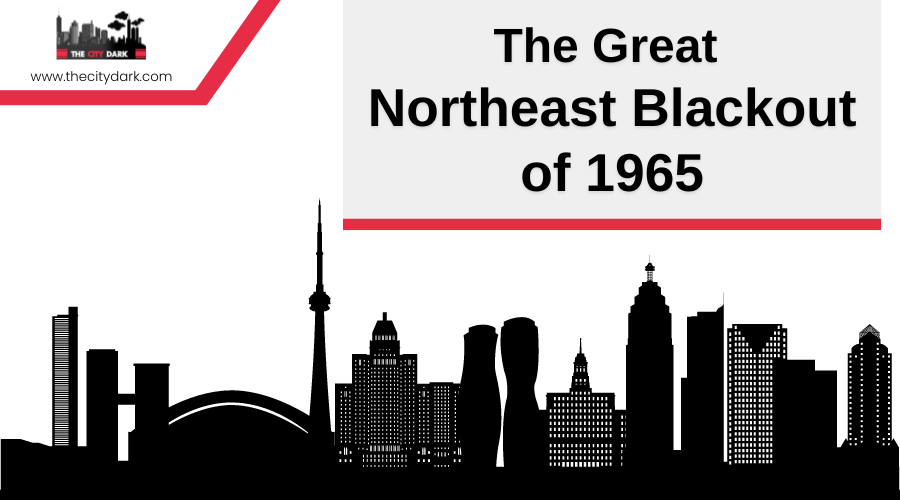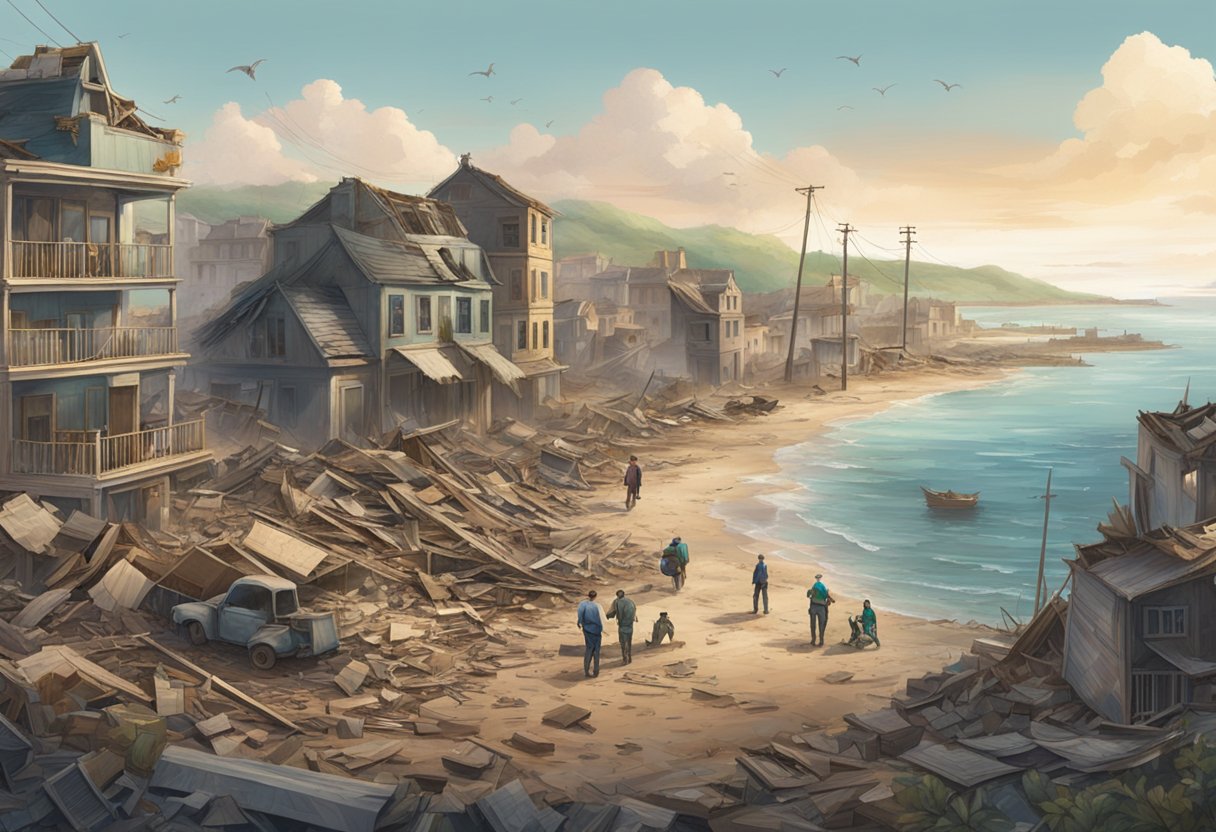The Great Chicago Fire of 1871: Myths and Realities Explored
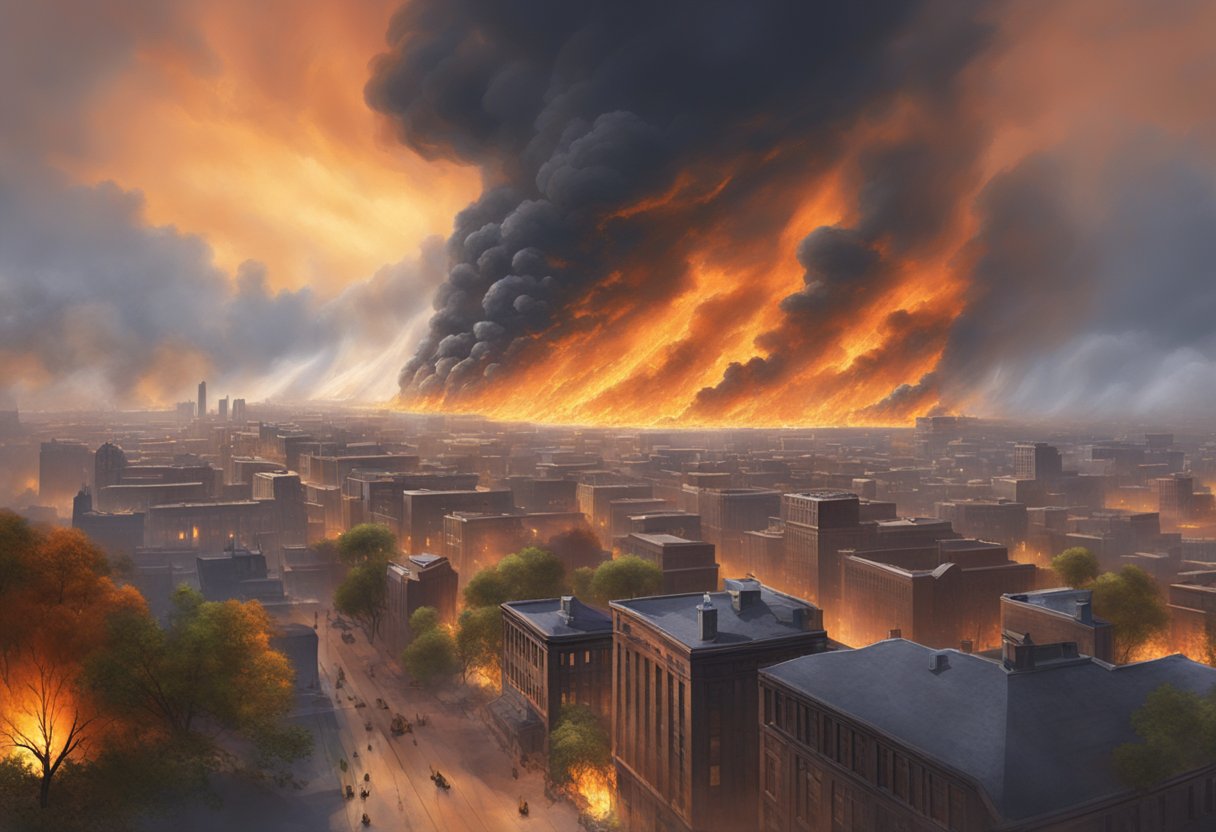
The Great Chicago Fire of 1871 was one of the most devastating events in American history. On October 8, 1871, a fire erupted in a small barn on the southwest side of Chicago and quickly spread through the city. The fire killed about 300 people, destroyed over 17,000 buildings, and left one-third of the city’s population homeless.
Many myths surround the origins of the Great Chicago Fire, the most famous being that Mrs. O'Leary's cow kicked over a lantern, igniting the blaze. This colorful story has been widely debunked, but it persists in popular culture. The true cause of the fire remains unknown, although conditions were ripe for a disaster, with dry weather and wooden structures throughout the city.
What followed in the aftermath was nothing short of remarkable. Chicago embarked on a "Great Rebuilding" effort, transforming the charred ruins into a modern urban center. Innovative building techniques and a surge in big business investments played a significant role in this transformation, setting the stage for Chicago to become a major American metropolis.
Historical Context
In the 19th century, Chicago experienced significant growth, fueled by immigration and economic expansion. This section explores the state of the city before the Great Chicago Fire of 1871, highlighting its rapid urban development, wooden buildings, population influx, and thriving business district.
Chicago in the 19th Century
Chicago in the 19th century was a rapidly expanding city, strategically located by the Great Lakes and a hub for transportation and trade. By 1871, Chicago had become a major player in the nation's economy, seeing its population grow exponentially.
After its incorporation in 1837, the city saw a population boom, growing from a few thousand to over 300,000 residents by the time of the fire. The growth was driven by its central location and the establishment of the railroad network, which attracted businesses and residents alike.
Urban Development and Wooden Buildings
Urban development in Chicago followed a hasty and often haphazard pattern. The city's rapid growth led to the construction of many buildings in a short period. Wooden buildings were predominant due to their low cost and the abundance of timber in the nearby regions.
However, this prevalent use of wood made the city particularly susceptible to fires. Streets, sidewalks, and even some sewage systems were made of wood. This flammable infrastructure played a crucial role in the spread and intensity of the Great Chicago Fire. Despite the risks, wooden buildings remained a popular choice because they were cheaper and quicker to build.
Immigration and Population Growth
The city's growth was heavily influenced by waves of immigrants from Europe. Irish, German, and Scandinavian immigrants were significant contributors to the population boom in the mid to late 19th century. These new residents sought opportunities in the booming city and played essential roles in its labor force.
Immigrants settled in various neighborhoods, often forming tight-knit communities. They provided the manpower needed for the city’s rapid industrial and commercial expansion. Chicago was seen as a land of opportunity, attracting people from across the globe eager to build new lives.
Economic Growth and the Central Business District
Driven by its strategic location and transportation links, Chicago's economic growth in the 19th century was monumental. It evolved into a central business district teeming with manufacturing plants, stockyards, and retail shops. Major publications such as the Chicago Tribune were headquartered there, reflecting the city's status as a media and cultural hub.
The business district became the heart of economic activity, with banks, businesses, and markets clustered together, contributing to a bustling and vibrant urban environment. This economic prosperity and concentration of assets would also be factors contributing to the extensive damages wrought by the fire.
The Origin of the Fire
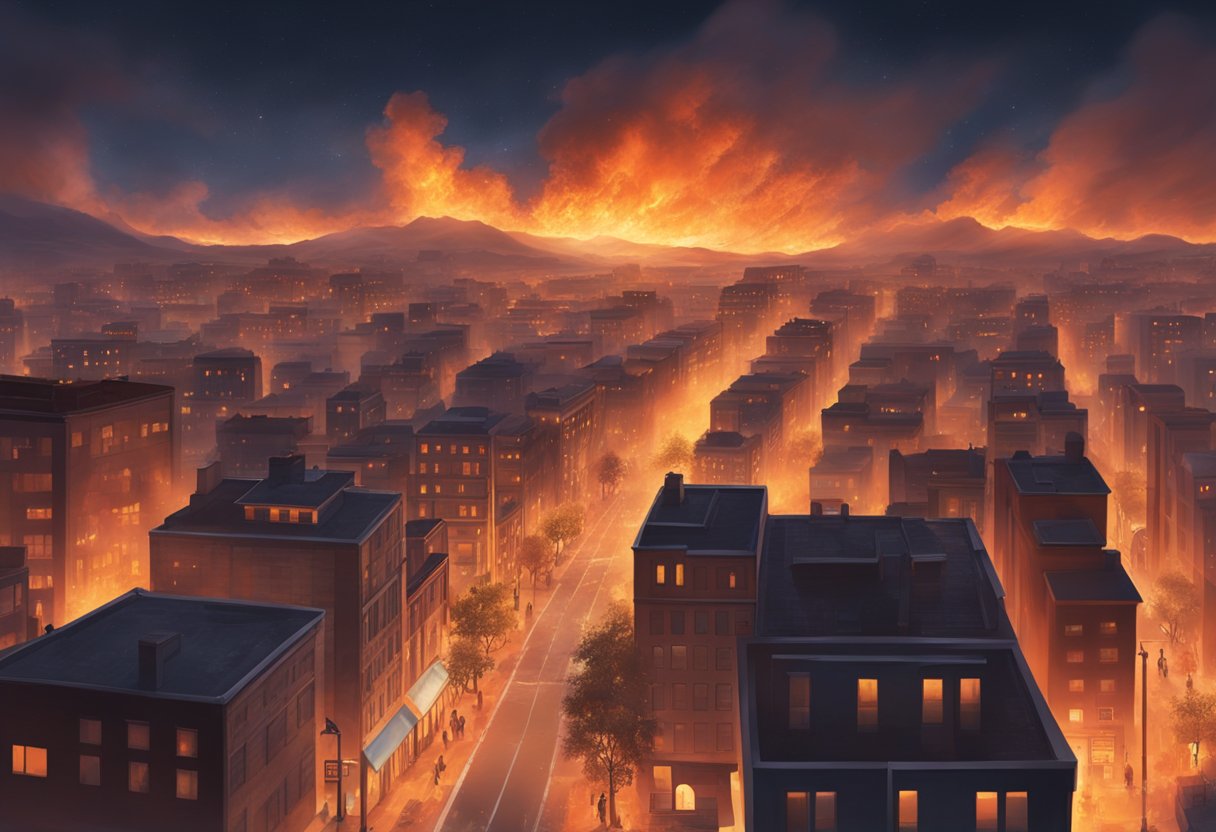
The origin of the Great Chicago Fire of 1871 remains a topic of interest and debate. The most widely accepted story involves the O'Leary family and their barn, while various alternate theories and speculations also exist.
The O'Leary Family and the Barn Incident
The Great Chicago Fire allegedly began in the barn of Patrick and Catherine O’Leary on DeKoven Street. The legend states that a cow kicked over a lantern, igniting the fire. Catherine O’Leary, an Irish immigrant, was often unfairly blamed for the disaster.
While no definitive proof exists that the cow and lantern story is true, it has nonetheless become a part of American history. The fire quickly spread due to high winds, wooden buildings, and dry conditions, leading to widespread destruction.
Alternate Theories and Speculations
Many alternate theories and speculations challenge the cow and lantern story. Some suggest that “fire devils” or small whirlwinds might have spread the flames faster. Others hypothesize a meteor shower could have ignited the fire, as other fires occurred in the Midwest that same night.
Some scholars argue that the cause may never be known for sure. Despite multiple theories, the exact origin remains one of the persistent mysteries surrounding the Great Chicago Fire.
The Fire's Progression
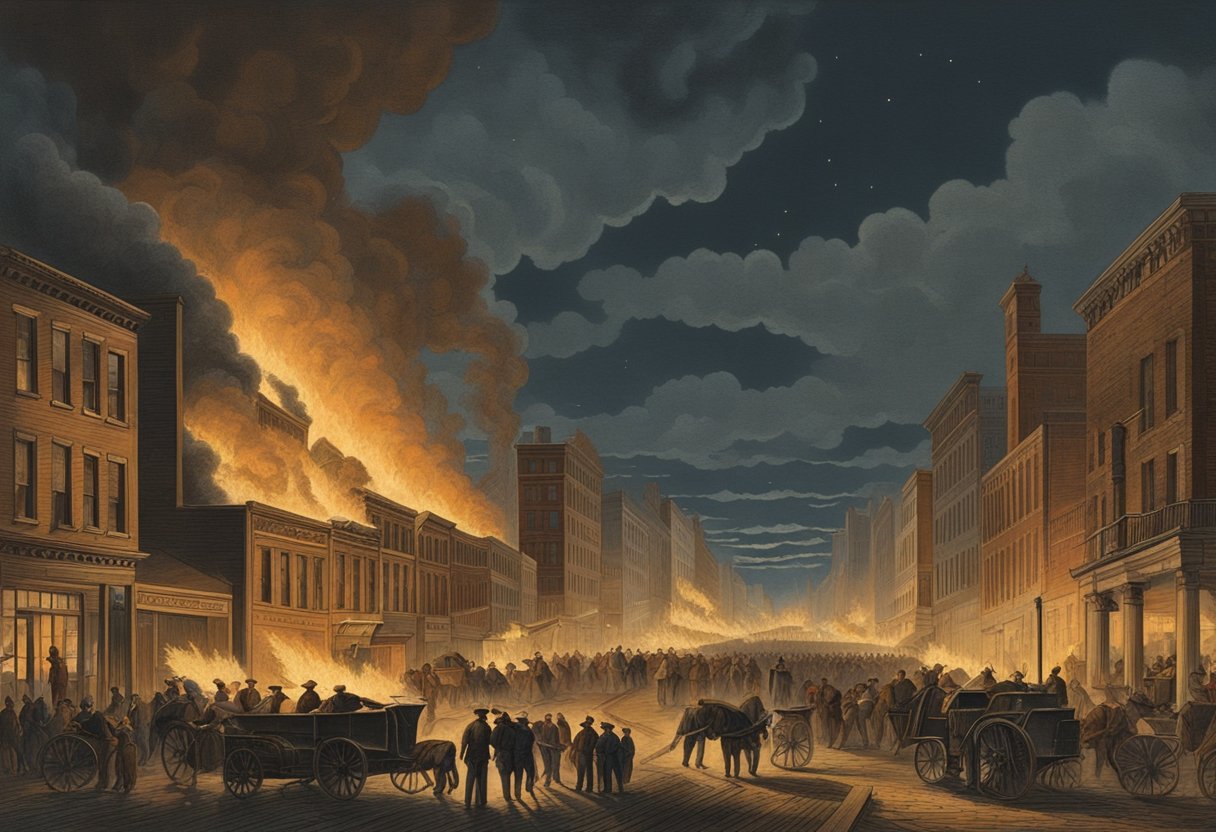
The Great Chicago Fire spread rapidly, wreaking havoc over a vast area and destroying numerous buildings. This section examines how the fire progressed and identifies the neighborhoods most impacted.
Spread and Intensity
The blaze began on October 8, 1871, in a small barn on the west side of Chicago. Strong winds and dry conditions caused the fire to spread quickly. Within hours, it had moved southwest from the city's center, engulfing wooden structures that fueled the inferno.
Flames leapt from one building to another, creating an intense conflagration. The fire's reach expanded to cover approximately 3.3 square miles (9 km²), aided by the wooden roads and sidewalks. The city's firefighting resources were completely overwhelmed.
By the time the fire was contained on October 10, thousands of structures had been consumed. The unstoppable blaze affected government buildings, homes, and commercial properties alike, reducing them to ashes.
Areas Most Affected
The fire's most devastating impact was in the densely populated areas. Over 17,000 structures were destroyed, leaving more than 100,000 residents homeless. The north side and central parts of Chicago suffered significant damage.
Prominent buildings, including hotels and department stores, were reduced to rubble. Government offices and newspapers were also not spared. Most of the destruction happened in neighborhoods with closely packed wooden homes, making it nearly impossible to stop the flames.
The west and north sides of the city saw the heaviest toll as the fire raged uncontrolled due to the lack of available firefighting equipment. By the time the fire was extinguished, entire city blocks had been left in ruins.
The Aftermath
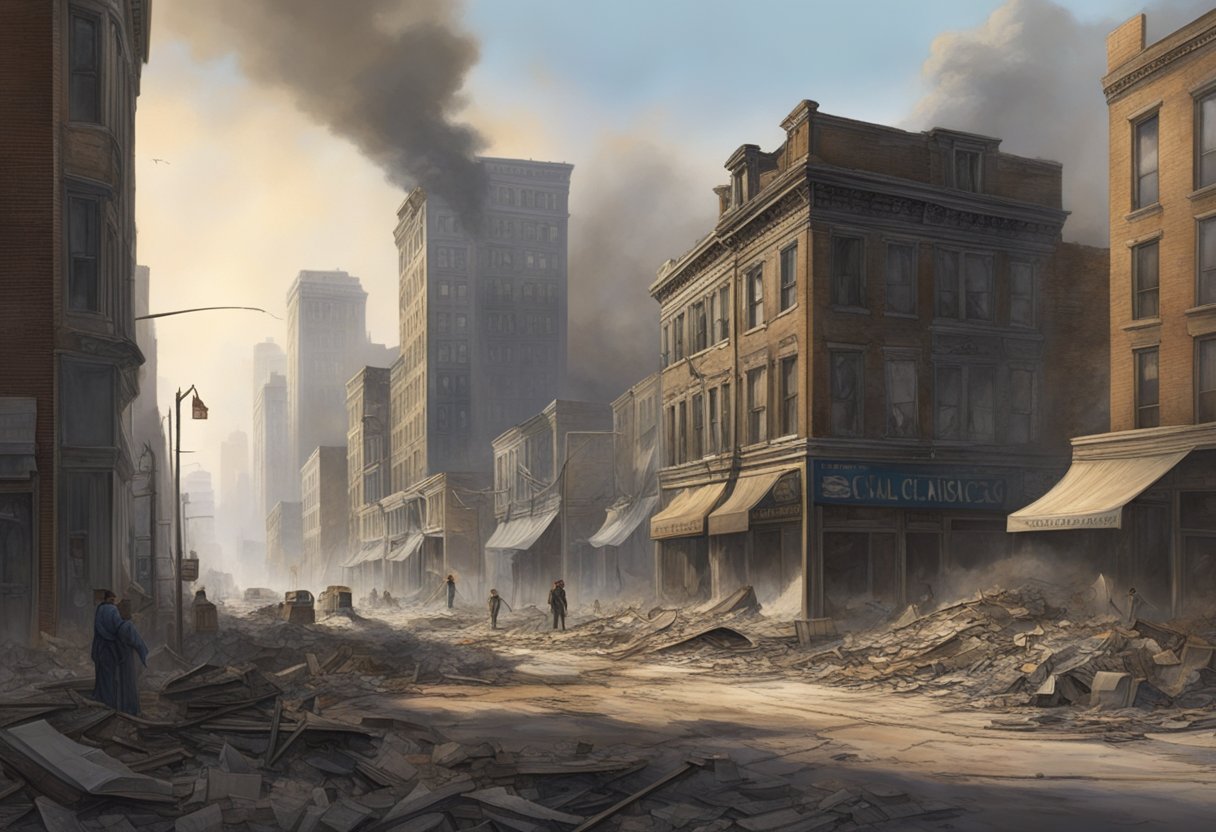
The Great Chicago Fire of 1871 left a profound impact on the city of Chicago, resulting in significant casualties, homelessness, and economic damage.
Casualties and Losses
The fire claimed the lives of approximately 300 people. Many of these individuals were trapped in their homes or in the buildings that collapsed.
In total, the fire destroyed around 17,450 buildings. The immense destruction spanned across 3.3 square miles of the city. The conflagration left an indelible mark, as it consumed homes, businesses, and public buildings that had taken years to construct.
Impact on Homeless Population
One of the most immediate effects of the fire was the sudden displacement of a vast number of residents. Over 100,000 people were rendered homeless, making up nearly one-third of the city's population at the time. The city had to quickly set up temporary shelters and ask for aid from other cities and organizations.
Many families were forced to live in tents or makeshift accommodations while the city began its long road to recovery. Humanitarian aid and support from various parts of the country played a crucial role during this period of crisis.
Economic and Property Damage
The economic consequences of the Great Chicago Fire were staggering. Property damage was estimated to be around $200 million, an enormous sum at that time. This included the loss of countless businesses, government offices, and most of the city's commercial district.
The destruction of property caused a significant economic downturn. Many businesses never reopened, and thousands of people lost their jobs. However, the fire also sparked the "Great Rebuilding," a vigorous reconstruction effort that paved the way for modern Chicago's architecture and design.
Response and Relief Efforts
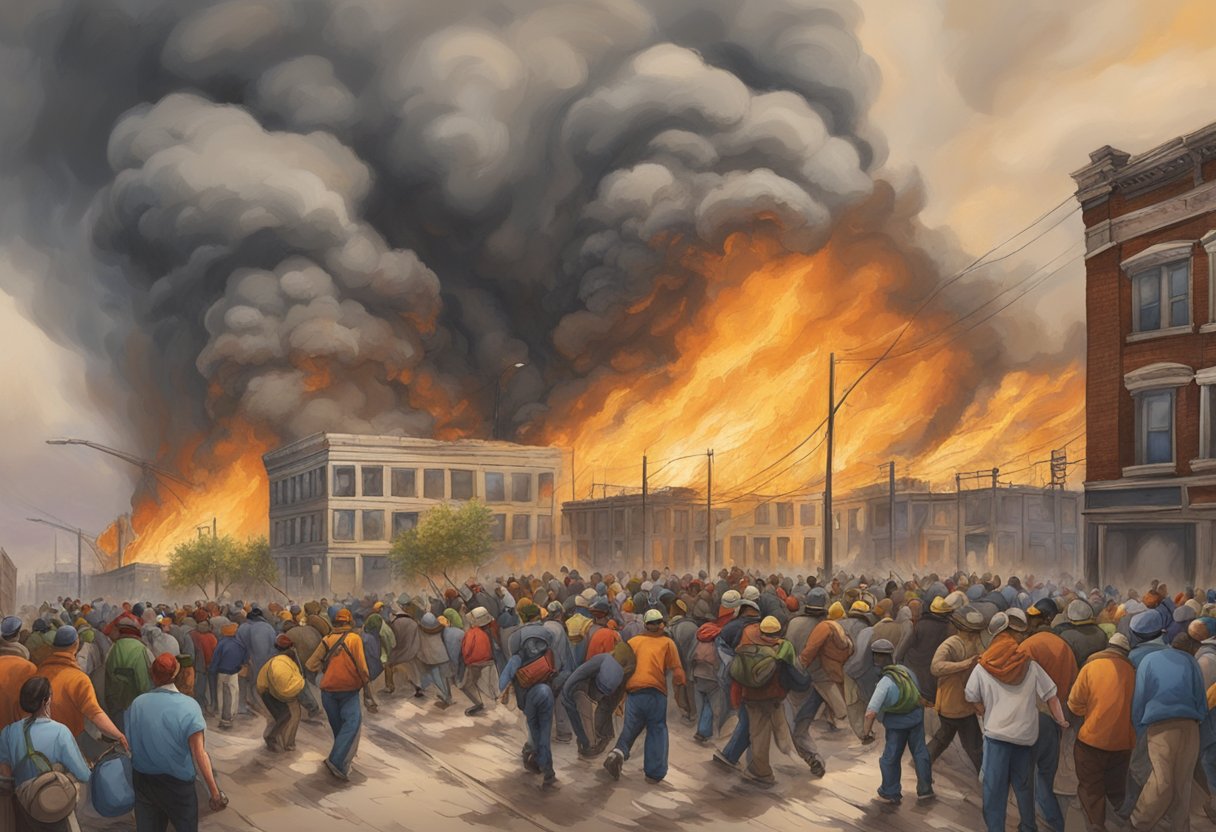
The Great Chicago Fire of 1871 caused immense destruction and suffering. Aid and relief efforts were crucial in addressing the immediate needs, and rebuilding the city. This response involved immediate resources, wider support, and long-term reconstruction.
Immediate Aid and Martial Law
The fire left a third of Chicago’s population homeless. Immediate aid included food, clothing, and temporary shelter. Local firefighters and volunteers worked tirelessly to control the remaining fires and rescue trapped individuals.
Martial law was declared to maintain order and protect property. Soldiers patrolled the streets to prevent looting and chaos. Mayor Roswell B. Mason and city officials set up command posts to coordinate these relief efforts effectively.
National and International Support
Support poured in from across the nation and internationally. Donations of money, food, and goods arrived from various cities and countries. The Chicago Relief Society was established to manage and distribute these resources.
Notable contributions included substantial funds and supplies from New York, St. Louis, and London. This unity and generosity played a pivotal role in assisting the thousands of displaced people and rebuilding the city's infrastructure.
Reconstruction Initiatives
The rebuilding of Chicago was an intense and determined effort. The "Great Rebuilding" focused on constructing fireproof buildings and improving urban planning. Insurance companies were critical, as they faced numerous claims yet facilitated the city's financial recovery.
Big businesses invested in new, innovative buildings, including hotels and commercial properties. This period saw the rise of modern skyscrapers and a more resilient urban design, transforming Chicago into a major metropolitan center.
Myths Versus Realities
The Great Chicago Fire of 1871 has inspired many myths and legends. Uncovering these stories reveals interesting facts and misconceptions about the event.
The O'Leary Cow Story
One of the most famous myths about the Great Chicago Fire is that it was started by Mrs. Catherine O'Leary's cow kicking over a lantern. This story claimed that the fire began in the barn of Mrs. O'Leary on the night of October 8, 1871.
Newspapers at the time sensationalized this tale. They blamed Mrs. O'Leary and her cow without solid evidence. Years later, it was revealed that this story was likely a fabrication. Catherine O'Leary denied the claim, and no proof ever surfaced to support the cow legend.
Other Legends and Exaggerations
Besides the cow story, other legends emerged about the fire. Some people believed that fireworks or a comet caused the blaze. These theories gained traction despite a lack of evidence.
In reality, the fire's true causes were more mundane. Dry weather, wooden buildings, and strong winds created perfect conditions for a large fire. Poor urban planning and limited fire-fighting resources also contributed to the spread and destruction. These practical factors offer a clearer understanding of how the fire grew so out of control.
Fire Prevention and Safety Reforms
After the Great Chicago Fire of 1871, significant changes were made to fire prevention and safety. Building codes were revised, the Chicago Fire Department was restructured, and community education on fire safety became a priority.
Changes in Building Codes and Materials
The fire highlighted the dangers of wooden buildings. Chicago introduced stringent building codes. They mandated the use of more fire-resistant materials such as brick, stone, and iron. These changes aimed to prevent future fires from spreading as quickly.
New regulations also included rules about the spacing between buildings. This was to ensure that fires would not jump easily from one structure to another. Additionally, the city implemented standards for fire escapes and exits.
Establishment of a Modern Fire Department
The Chicago Fire Department saw major changes after the disaster. The department was expanded and better organized. A significant addition was the role of the fire commissioner. This individual was responsible for overseeing all aspects of fire safety and management.
The upgrades included more modern equipment. Steam-powered fire engines replaced older models. More fire stations were built across the city, reducing response times. Training for firefighters became more comprehensive, focusing on new techniques and safety protocols.
Education and Community Awareness
Public education became a crucial part of fire prevention. Schools included fire safety in their curriculum. Children learned what to do in case of a fire and how to use safety equipment like extinguishers.
Community programs were also established. These initiatives aimed at teaching adults about fire codes, the importance of following safety regulations, and how to perform basic fire drills.
Events like Fire Prevention Week, which commemorates the Great Chicago Fire, served to keep fire safety in public awareness. These efforts helped to build a culture of preparedness and vigilance.
The Rebirth of Chicago
After the Great Chicago Fire of 1871, the city faced the immense task of rebuilding. This effort led to significant advancements in architecture and urban planning, transforming Chicago into a modern metropolis.
The Rise of the Skyscraper
One of the most notable developments was the rise of the skyscraper. Chicago became the birthplace of skyscrapers with the construction of the Home Insurance Building in 1885, designed by William Le Baron Jenney. This building is considered the world's first skyscraper, using a steel-frame construction that allowed it to reach unprecedented heights.
The innovation didn't stop there. Soon, architects like Daniel Burnham and John Wellborn Root contributed to this vertical expansion. Their work set the stage for Chicago's iconic skyline, making the city a pioneer in modern high-rise architecture.
Architectural Innovation and Notable Architects
The period following the fire saw a surge in architectural innovation. Architects such as Dankmar Adler and Louis Sullivan emerged as key figures. Sullivan, often called the "father of skyscrapers," developed the concept of "form follows function," influencing many future designs.
William Holabird and Martin Roche also played pivotal roles, particularly in refining the Chicago School style. These architects emphasized both aesthetic appeal and practical construction methods, combining functionality with beauty.
Their efforts led to the creation of architectural landmarks that still stand today. These include the Auditorium Building designed by Adler and Sullivan, which blended structural ingenuity with artistic detail.
Cultural and Civic Developments
The rebirth of Chicago wasn't limited to physical structures. Cultural and civic advancements also flourished. In 1873, the Chicago Public Library was established, promoting education and literacy among the city's residents. The library's growth mirrored the city's rapid recovery and cultural development.
Efforts to improve civic infrastructure were also significant. Daniel Burnham's Plan of Chicago, unveiled in 1909, laid out a vision for a more organized and aesthetically pleasing city. His plan included the development of parks, civic buildings, and improved transportation routes.
These cultural and civic developments helped shape Chicago's identity as a vibrant, forward-thinking city, ensuring its place not just as an economic powerhouse but also as a cultural and architectural leader.
Legacy and Memory
The Great Chicago Fire left a lasting impact on the city's cultural memory and has been commemorated in various ways. It has also permeated popular culture, shaping how people remember the event.
Commemoration and Museums
Chicago has numerous memorials and ceremonies dedicated to the fire. Every year, the city holds events to honor those who lost their lives and to remember the resilience shown during the rebuilding process.
The Chicago History Museum plays a key role in preserving artifacts and records from the fire. Exhibits here include eyewitness accounts, photographs, and items recovered from the ruins. These exhibits help in understanding the fire's impact on the city's history and cultural memory.
Plaques and monuments around Chicago mark significant locations related to the fire, such as the site of the O'Leary barn where the fire allegedly started. These memorials serve both as a tribute and as educational tools for the public.
The Great Chicago Fire in Popular Culture
The fire has been a subject in various forms of media. Books, movies, and television shows often depict the fire, sometimes focusing on the myths and legends surrounding it, such as the tale of Mrs. O'Leary's cow.
Literature and films sometimes dramatize the event, but they also keep the story alive for newer generations. For example, books have been written that explore not just the event, but its impact on the city's architecture and society.
In addition, the fire frequently appears in local folklore and educational materials, cementing its place in both historical studies and cultural discussions. These portrayals often emphasize not just the tragedy but the spirit of renewal that followed.

